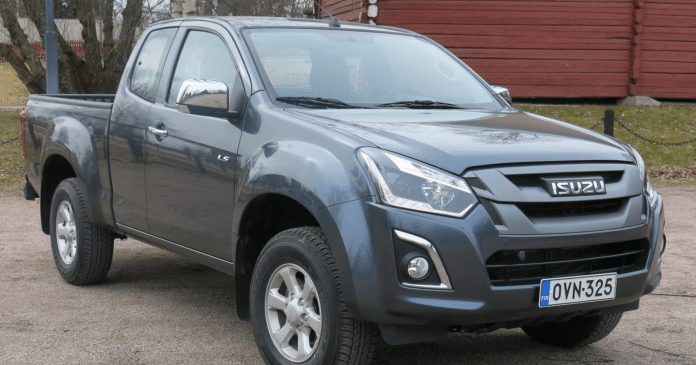The Isuzu D-Max pick-up truck has been on the market since the early 2000s. Now the latest updated version has arrived in Finland.
Last year, more than 1 400 models were sold in Finland. By far the most popular model was the Toyota Hilux, with over 400 units sold. The Isuzu D-Max was in sixth place with 94 vehicles sold. The D-Max had a market share of 6.6% last year.
Isuzu is now looking to increase its market share with its renewed model. In Europe, one in seven convertibles sold is an Isuzu D-Max. In Finland, the aim is to achieve a market share of more than 10%.
The redesign has given the Isuzu D-Max a more streamlined look. But the main changes are not visible from the outside, with a new engine, new gearboxes and more equipment. Despite the improvements, the revised D-Max is more affordable than before.
A tool for the job
The D-Max is essentially a tool, and in that sense the driver’s seat is extremely important. A short test drive found nothing to complain about in the driver’s seat, but anyone considering a purchase should give the car a good test drive.
The car has a number of small compartments for carrying small items.
The car can be used in either rear-wheel drive or four-wheel drive. For off-road use, there is a dedicated four-wheel drive, which can only be engaged when the car is stationary. In this driving mode, the stability control is automatically disengaged.
During the test drive, the car could only be tested on hard-packed roads, and the off-road capabilities of the car could not be tested. The car was also not loaded, which has a big influence on the driving characteristics.
During the short drive, the car behaved logically and did not surprise at any point. Of course, a workhorse of this kind is not the quietest of drivers, but the noise was not in any way disturbing.
Getting in and out of the car is easy, as the seat is at the right height and there is no threshold to speak of.
In the Space Cab model, access to the rear of the seats is facilitated by a folding door. This makes it easy to access the space behind the seats.
Double Cab models have a traditional door to the rear seat.
Appearance is deceiving
At first glance, the new Isuzu D-Max doesn’t appear to have changed much, but the entire front end has been redesigned.
According to Isuzu, safety has been improved by, among other things, the design of the bonnet, the recessing of the fog lights and the hiding of the windscreen wipers under the rear edge of the bonnet.
Small but significant improvements continue at the rear, where a spoiler has been shaped into the top of the new tailgate. Better-equipped models have alloy wheels. They have been increased to 18-inches on the most luxurious LSX trim level.
The car has a clearer instrument cluster with the addition of a shift light. Except for the base model, the D-Max has a trip computer that even shows the particulate filter’s fill level.
All but the LX trim level have a chunky 7-inch touchscreen for audio, phone and a host of other functions.
An important addition to the equipment list is a reversing camera. The system is also equipped with bluetooth and you can connect your own music player to the car via a usb connection. There are also two usb charging sockets in the cabin.
The redesigned D-Max has hill start assist and hill descent control.
One engine option
There’s no need to think about engine options when considering a car, as there’s only one diesel engine option.
Isuzu’s new 1.9-litre turbodiesel develops 120 kW (163 hp) / 3 600 rpm and 360 Nm / 2 000 – 2 500 rpm.
Isuzu’s engine meets Euro 6 emission standards without additives. The engine meets emission standards with exhaust gas recirculation and a particulate filter.
In addition to the engine, Isuzu developed a new manual and automatic transmission for the D-Max. The three lower gears of the manual transmission are triple-synchronised and the reverse gear is also synchronised.
The new automatic transmission has six gears. In combination with the new engine, Isuzu says it reduces fuel consumption. The driver can also change the gears in the automatic box himself.
Reduced emissions
According to Isuzu, consumption and CO2 emissions are 4 to 18 percent lower than before. Only four-wheel drive D-Maxes will be imported to Finland, with CO2 emissions of 183 g/km (- 9 g/km) with manual transmission and 205 g/km (- 15 g/km) with automatic transmission.
Both acceleration from a standstill and durability have been improved. The automatic D-Max now accelerates from zero to 60 km/h in 12.9 seconds (0.6 s improvement).
The new engine is more than fifty kilos lighter than before, which has increased the D-Max’s load capacity. The Space Cabin now has a load capacity of 1 120 kilos, an increase of 60 kilos on the previous version, while the Double Cabin has a load capacity of 1 085 kilos ( 30 kg).
The trailer weight of the Isuzu D-Max remains at 3 500 kilos.
The cheapest version costs less than 30 000 euros
Prices for the redesigned Isuzu D-Max Space Cabin start at €29,995 for the LX trim. The better equipped LS is available with manual gearbox for €34 395 and automatic for €37 996.
Prices for the D-Max Double Cabin with long crew cab start at €35 395. It is available with automatic transmission and LSX trim (including leather upholstery) for €43 996.
D-Max Double Cabs registered for five are priced between €8 000 and €10 000





